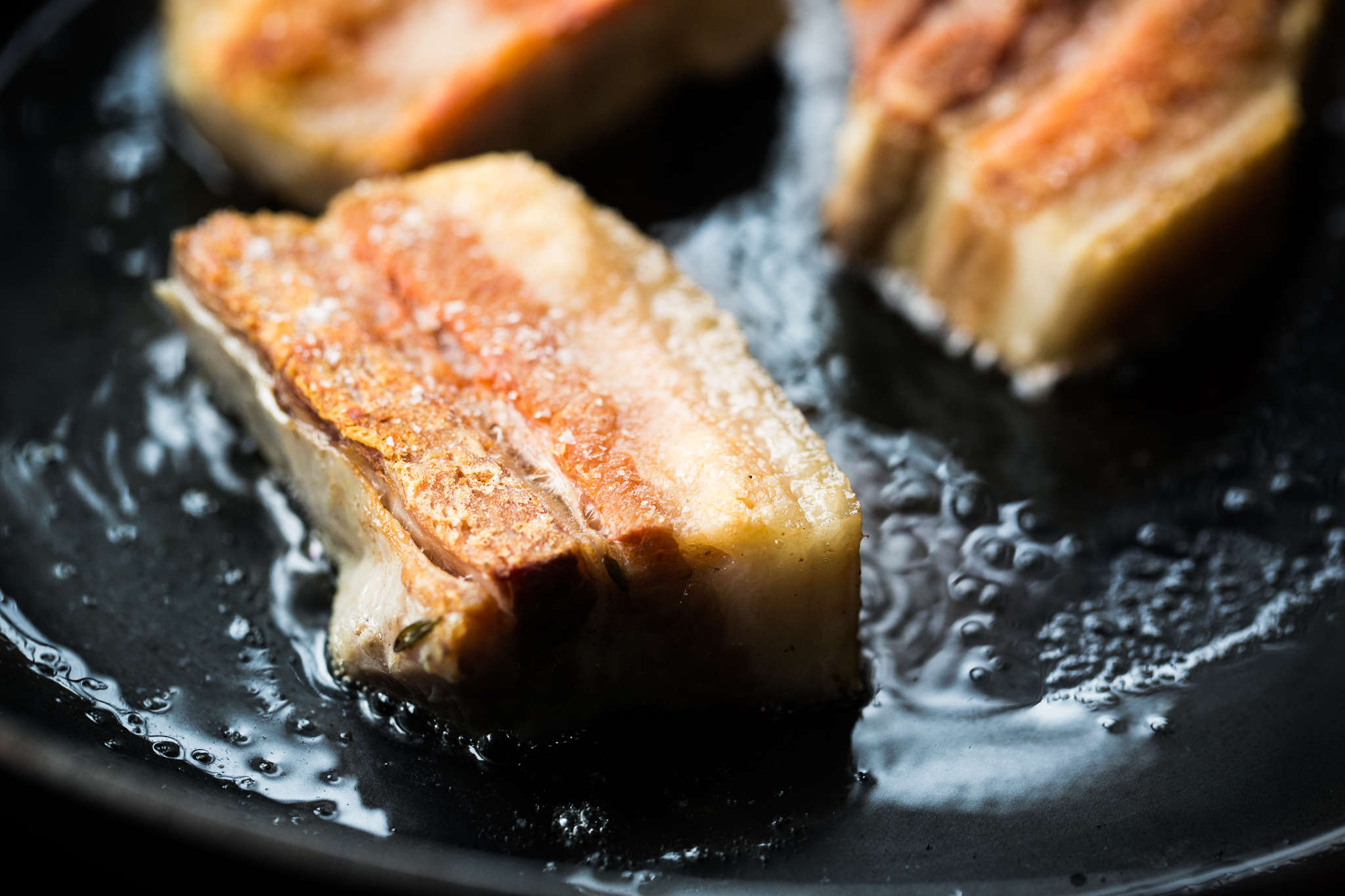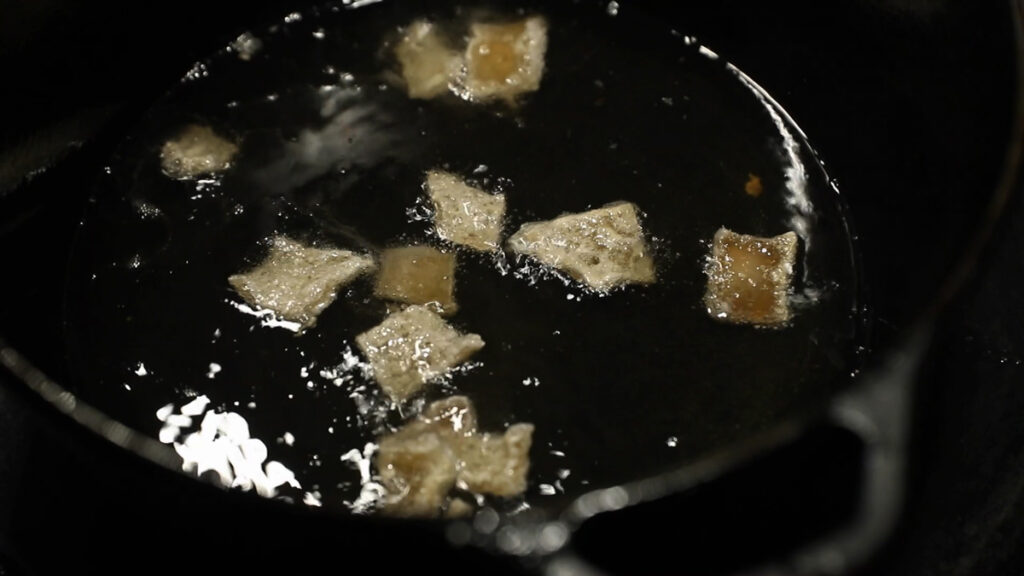However, don’t feel disqualified if you’re not raising your own pigs. There are still ways for you to acquire pasture-raised pork fat to make lard.
Let’s talk about what lard is, why it’s better for you than other fats, and how you can make it at home using pork fatback or pig leaf lard in a Dutch oven, crock pot, or pot that you cook on the stove.
While cooking pork fat, the meat, tendons, and tissues separate from the fat. This is called lard. It will turn white and have a creamy texture, like Crisco, which is used today for cooking and baking, after it has been strained and cooled (see picture above).
Pork belly is a hugely versatile cut of meat that’s loaded with flavorful fat just waiting to be rendered into liquid gold. Rendering pork fat into lard at home may sound intimidating, but it’s actually quite simple with the right techniques.
In this comprehensive guide, we’ll walk through everything you need to know to render gorgeous pork belly fat into pure, homemade lard.
Why Render Your Own Pork Fat?
There are a few excellent reasons to render pork fat at home:
-
Make high-quality lard for cooking and baking – Homemade lard imparts incredible flavor when used for frying sauteing and baking.
-
Render fat to confit pork belly – Confiting involves slowly cooking meat in its own fat. Rendering allows you to do this.
-
Prepare chicharrones/pork rinds – Frying the skin after rendering yields incredibly crispy cracklings.
-
Improve texture – Removing excess fat leaves just the tender, meaty portions of the belly
-
Extend shelf life – Clarified lard keeps for months in the fridge or freezer
Rendering concentrates the flavors and allows you to make the most of the fat and the meat.
Step-by-Step Guide to Rendering Pork Fat
Follow these simple steps for perfect homemade lard every time:
1. Cut Pork Belly into Strips
-
Cut the pork belly into 2-inch wide strips. This increases the surface area for faster, more even rendering.
-
Leave the skin on if you want chicharrones later.
2. Add Fat to Pot on Low Heat
-
Place your pork belly strips into a heavy bottomed Dutch oven or pot.
-
Set over low heat on the stovetop.
3. Cook Slowly to Separate Fat
-
Cook for 2-3 hours, stirring occasionally to prevent sticking.
-
The fat will slowly render out and collect in the bottom of the pot.
-
Add a little water if the fat starts to brown before fully rendering.
4. Strain the Liquid Fat
-
Pour the hot rendered fat through a mesh strainer to remove any little bits.
-
Cheesecloth or coffee filters also work for straining.
5. Save the Cracklings
- Removed the crisped pork skins and set aside to enjoy as chicharrones!
6. Store the Fresh Lard
-
Allow the liquid lard to cool slightly and pour into an airtight container.
-
Refrigerate for up to 6 months or freeze for up to 1 year.
Tips for Perfect Results
Follow these tips when rendering pork belly fat:
-
Cut the fat into uniform, smaller pieces for even rendering.
-
Cook over very low heat, never letting it reach a boil.
-
Stir the fat occasionally as it renders to prevent sticking.
-
Add a bit of water if the fat browns before fully rendering.
-
Cook for 2+ hours for complete fat separation.
-
Strain lard through cheesecloth when hot for purity.
-
Let lard cool before storing in the fridge or freezer.
Take your time and use low heat for the highest quality homemade lard.
Delicious Uses for Homemade Lard
The possibilities are nearly endless when cooking with your homemade pork lard:
-
For frying potatoes, eggs, meats, etc. Adds amazing flavor.
-
In baking savory pies, biscuits, cookies, and pastries.
-
To confit and preserve duck, pork, and chicken.
-
For sautéing aromatics like garlic and onions.
-
In place of oil when making roux.
-
To add rich depth to stews, beans, soups.
-
Brush on meats before roasting for crispy skin.
-
Season cast iron skillets and pans.
Rendering pork belly fat may take time, but the homemade lard is well worth the effort. Follow this simple process for pure, flavorful lard you can use in all sorts of delicious ways.

Types of Fat for Rendering Lard
The best lard comes from homegrown pasture-raised pork. There is no way of knowing what commercially raised pigs eat or how they are medicated. We don’t want to make our lard from the fat because that’s where the bad things are kept.
Also, be very careful when buying lard at the grocery store. If you don’t have pastured pigs, check with a local butcher you trust. Perhaps he will have pig fat on hand, or he can point you in the right direction to get some.
The three types of pork fat are as follows:
- This is where the bacon lives: the pork belly. Meat isn’t a good choice for making lard because it has fat in it.
- Fatback: As the name suggests, this fat comes from the back end of the pig. It smells stronger like pork, so it’s not good for baking, but it tastes great in fried foods or sautéed vegetables.
- Leaf Lard, also called Leaf Fat, comes from the fat around the kidneys. If it’s made right, it has a mild taste and turns creamy white when it cools. Your pastries, biscuits, and cookies will taste like your grandmother’s!.
Why Has Lard Received a Bad Rap?
In the early 1900s, cottonseed was an unwanted and useless part of the cotton plant. Crisco was made by processing cottonseeds very thoroughly and hydrogenating the oil that was taken out.
Until Crisco, lard had been a staple in every kitchen, and lard was a tough competitor. As a result, excessive marketing dollars propagated a misconception that lard was dangerously unhealthy.
Studies revealed the dangers of hydrogenated oil when previously unknown health conditions started to occur. People are still hesitant to eat lard because it is high in fat, but we believe in the saying “all things in moderation.” ”.
Eating foods in their natural, raw form will always be healthier than highly processed junk!

How To RENDER PORK Leaf Fat For Lard
FAQ
What temperature does pork belly fat render at?
How long does pork fat take to render?
Can I make lard from pork belly?
How to render pork fat?
When it comes to rendering pork fat, the first step is to obtain the pork fat itself. This can usually be obtained from a butcher or from pork products such as bacon or pork belly. It’s important to note that the pork fat should be clean and free from any meat or other impurities. Once you have the pork fat, it’s time to prepare it for rendering.
What is the best way to reduce belly fat?
The vast majority of scientific evidence shows that localized fat reduction is not possible and that fat loss tends to spread to the entire body, not to the part of the body that is desired. To lose body fat, it is necessary to have a caloric deficit, in other words, consume less energy than the body needs.
Is pork belly fat used to make lard?
Fatback: This comes from the back of the pig, includes the shoulder and rump areas, and is the thick layer of fat directly underneath the skin. Pork belly has become popular in recent years in a variety of cuisine. You typically wouldn’t render the belly into lard because there is too much meat attached.
How long can you keep rendered pork fat?
Yes, you can store rendered pork fat in an airtight container in the refrigerator for up to six months. It can also be frozen for even longer storage. 5. Are there any special considerations for rendering pork fat? One important consideration when rendering pork fat is to keep an eye on the heat.
